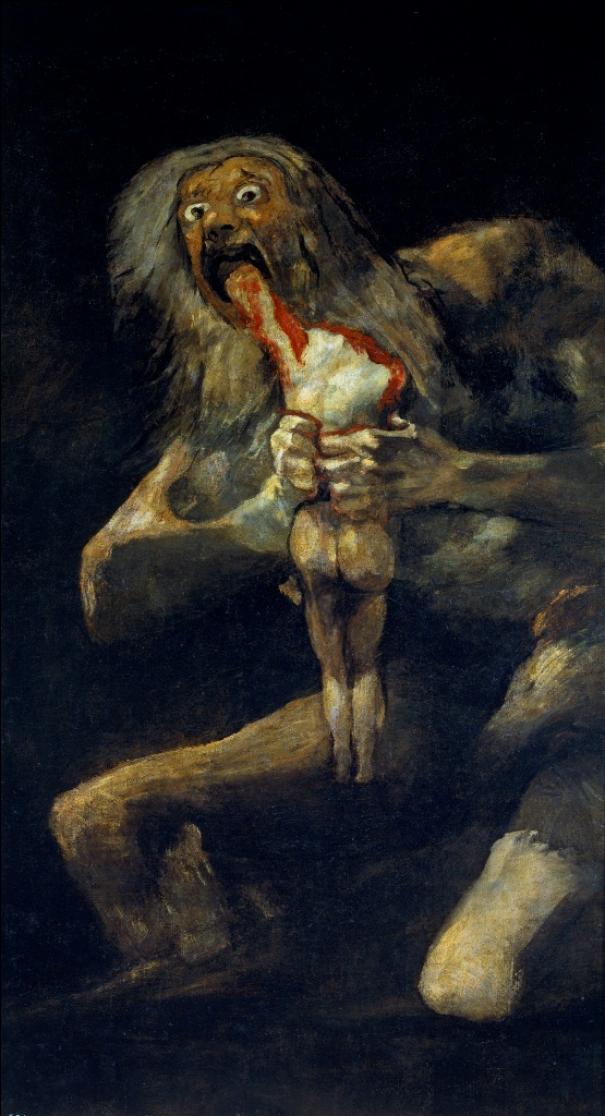Saturn Devouring His Children
Documentation:
Fred Licht points out a connection between Goya's image and contemporary anti-Semitism:
"To Goya's contemporaries, the story of Saturn was not the only story that involved the killing and eating of infants. Among the persistent legends that were constantly fostered, especially by more ignorant clergymen, there was the quite widely believed notion that Jews, in order to make their Passover bread, needed the blood of a Christian infant. Goya, who had all his life fought against harmful superstition and false beliefs, must have been familiar with this old story. All over Europe, printed broadsides, as well as painted and even sculptural representations of this story, kept the population eternally agitated against the Jewish communities. Most of these nomuments and paintings have disappeared, swept away during the 19th-century liberalization of religious policy. However, a few, such as the Kindlifresserbrunnen [Child Eater Well] at Berne [Switzerland], still survive. It may be that a thorough investigation of popular images and broadsides will reveal that illustrations of the ritual eating of children on the part of Jews were still widespread in Spain and that Goya, always alert to the vigor and expressiveness of popular imagery and popular imagination, derived his image from the so-called blood-libel legend as well as from the Greek legend of Saturn."
Fred Licht, Goya. The Origins of the Modern Temper in Art (New York: Universe Books, 1979), 169-70.
Nigel Glendinning explains how Goya’s “Black Paintings” came to the Prado:
“The French banker of German origin, Baron Frédéric-Emil d’Erlanger, who apparently bought Goya’s house in March 1873 in the belief that property to the west of Madrid was ripe for development, paid about 42,500 for the paintings to be transferred to canvas…showed them at the Great Exhibition [World’s Fair] in Paris in 1878, and gave them to the Spanish government three years later. Salvador Martinez Cubells (1845-1914), an artist who had been appointed Chief Restorer at the Prado in 1869 at the age of twenty-four, supervised the transfer and restored the paintings between 1874 and 1878.”
Nigel Glendinning, “The Strange Translation of Goya’s ‘Black Paintings,’” The Burlington Magazine, vol. 117, no. 868 (July 1975): 466.
Jay Scott Morgan speculates on the inspiration for Saturn Devouring His Children :
“Goya produced a chalk drawing, Saturn Devouring His Sons, in 1796-97, most likely influenced by a Rubens painting of the same subject in Madrid’s Royal Collection. Both works are illustrative of a literary theme, passionless, even morbidly comic. Rubens’s Saturn is out on a stroll, his foot resting momentarily on a stone, one hand holding his staff, the other grasping his meal – his infant son – biting into the boy’s chest like ‘a sturdy Flemish burgher stooping to a roast goose,’ to quote Wyndham Lewis. Goya’s Titan is cunning-eyed; his mouth, clamped upon his son’s leg to the thigh, is turned upward in a leering grin; the legs of a second son he holds almost daintily, his pinky slightly raised….
Goya and his wife, Josefa, had numerous children – between five and twenty: the exact number is unknown. Only one boy, Javier, survived beyond childhood….I wonder: did the early deaths of his other children, reflected upon in the solitude of the Quinta del Sordo [House of the Deaf Man] – the house he moved into in 1819, seven years after Josefa died – inspire Goya’s vision of the cannibal god?”
Jay Scott Morgan, “The Mystery of Goya’s Saturn,” New England Review, vol. 22, no. 3 (2001): 40.
John Ciofalo speculates that the figure being devoured is female and offers the following interpretation:
“Goya’s Saturn is not devouring his male sons as mythology would have it, and as Rubens, and also Goya in his earlier drawing, had shown him. Here the victim appears to be an adult and, given the curvaceous buttocks and legs, a female. Moreover, in the other versions, the sons are alive and struggling or at least have heads, so the viewer is more able to identify or sympathize. This victim is not struggling in Saturn’s vice-like, blood-oozing grip, which literally cuts into her body, because she is already dead, not to mention headless. She does not, to say the least, encourage identification. The identification here flows toward Saturn. The overwhelming feeling of the image is one of violent and insatiable lust, underscored, to put it mildly, by the livid and enormously engorged penis between his legs. Utter male fury has hardly before or since been captured so vividly.
Saturn is an image of a myth stripped to its violent core….”
John J. Ciofalo, The Self-Portraits of Francisco Goya (New York-Cambridge, UK: Cambridge University Press, 2001), 157-9.
Poet Frederick Turner (b. 1943) wrote a poem in 1984 inspired by Goya’s Saturn Devouring His Children. This is an excerpt:
On Goya’s Saturn
That god who stares from the picture-space
As if he—only now it’s done,
The madness slaked—can recognize the face
Whose blood and brains he gulped, to be his son,
Catches the humanist’s eye.
Chronus, blind time, knowing himself again
To be Kronos the wretched King,
Squirms like a frog across the void. His pain
Goya suggests in the stiff dance he’s doing;
The dark shape of why
Is shadowed in the history of Spain.
The deed of sacrifice once done
Is such as never can be done again.
The naked body of the beloved son
In his sire’s hand must die.
Similar Subjects by Other Artists:
Ilya Repin, Ivan the Terrible and His Son Ivan, 1885 (Tretyakov Gallery, Moscow)
Peter Paul Rubens, Saturn Devouring One of His Sons, 1637 (Prado, Madrid). This painting was in the Spanish royal collection in Goya's time and was undoubtedly inspirational.
Web Resources:
About the Artist
Died: Bordeaux, France, 16 April 1828
Nationality: Spanish


 Buy the Book
Buy the Book